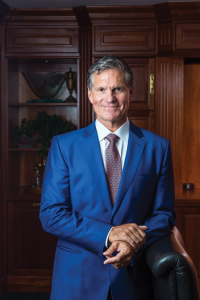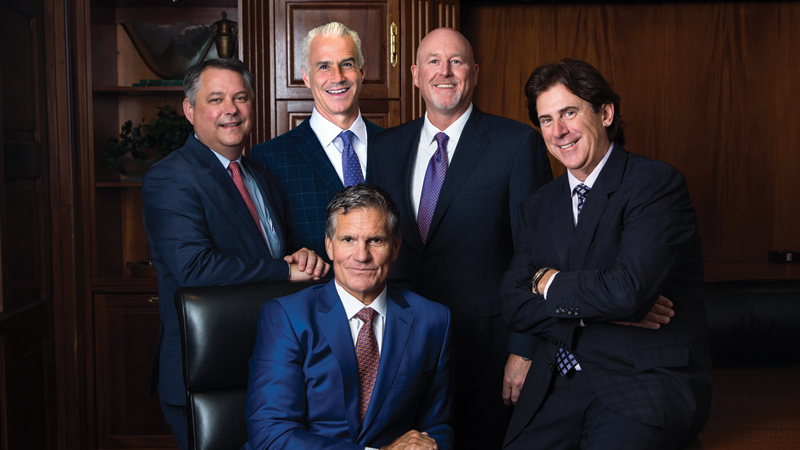
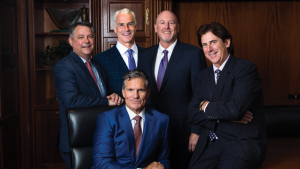
Scott Oppenheimer, Regional President Control States & Canada; Patrick Dual, President West Region; Mike McLaughlin, President Central Region; John Wittig, President East Region; and Brad Vassar, Executive Vice President, Chief Operating Officer.
The completion of the merger between Miami-based Southern Wine & Spirits and Dallas-based Glazer’s Inc. last summer created the largest wholesaler in North America. One year later, the Southern Glazer’s National Leadership Team describes why bigger means better for both suppliers and customers.
By Kristen Bieler, Photographs by Andrew Kist.
With operations in 44 states, Canada and the Virgin Islands, the 21,000-person Southern Glazer’s Wine & Spirits (SGWS) distributes more than 150 million cases of wine and spirits each year to approximately 370,000 customers for a revenue stream of about $18 billion. Which translates to over one-third of the wine and spirits market, by value.
These are numbers that make a lot of people in the beverage alcohol industry uncomfortable. Being extremely large is not considered a wholesaler virtue by many suppliers and retailers, who fear the erosion of leverage and service. Brad Vassar, Executive Vice President and Chief Operating Officer, SGWS, wants the industry to know that the opposite is true: “Execution is the number one job of a distributor, and every investment we make—whether it is in training or technology—is focused around making us better at it.”
Vassar, who has been with Southern for 26 years, serving as the COO for the last six, has seen the organization grow dramatically, yet insists “the heart of this company has stayed the same. Even though we’re as big as we are—and are now a different company with a different name—there is a very strong feeling that we are still a family-run company and the people here are part of that family.”
Timing is Everything
The idea to combine these two businesses was not a new one: A merger was first attempted in 2008, but was abandoned. What changed? “The Glazer’s we are in business with today is a different Glazer’s that we saw in 2008,” says Vassar. “But more importantly, the business in general wasn’t ready for it. The supplier community wasn’t behind it in the way that it is today.”
Vassar believes supplier consolidation and an increasing focus on the U.S. as the most emerging, profitable and important wine and spirits market on the planet, served as critical factors. “In many other countries, these suppliers work with a single distributor platform, and wondered why they couldn’t do that in the U.S.,” he says.
Bacardi’s decision to align nationally with the newly combined company—announced within days of the merger—was a ground-breaking first, and has since been followed by similar nationwide partnerships with other major suppliers.
The Culture Connection
On paper, Southern and Glazer’s were ideally suited to team up. For one, they had complementary footprints and little market overlap, with Southern strong on both coasts and Glazer’s core in Texas and the Midwest. Each company also brought unique supplier relationships.
But it turns out they had more in common than even they had realized. “Our cultures are surprisingly aligned,” adds Steve Slater, EVP, General Manager, Wine. “We both have a strong customer-first culture which adds value to our supplier base. And we both want to win.” The executive leadership coming from each company helped make the transition seamless. “There was no crisis of leadership, which can be typical in mergers of this size,” says John Wittig, President, Eastern Region. “Southern and Glazer’s have a legacy of family-driven direction with visionary patriarchs. Between Harvey Chaplin, Bennett Glazer, Mel Dick and Wayne Chaplin, we share a similar high integrity and a willingness to compete.”
The families’ unanimous refusal to cut financial corners has been a huge factor in SGWS’s early success, believes Scott Oppenheimer, President, Control States & Canada: “The owners of these companies over-planned and invested massive resources to ensure a smooth transition. Quite quickly, we were all marching in the same direction and embracing the same culture.”
Becoming One
Which is not to say there weren’t challenges. Merging both entities while at the same time integrating the Bacardi business across the company’s national footprint made for a myriad of logistical hurdles: “It was an extraordinary time; there was a lot going on in a very short period,” Vassar admits.
“The most critical thing was making sure our people understood who they needed to communicate with, that they were getting paid, that our bills were getting paid; it was a massive IT job. It was a huge HR job as well; my biggest concern was our employees who were thinking: ‘How is this going to impact me?’ I would hope that one year later they see the reasons why we did this.”
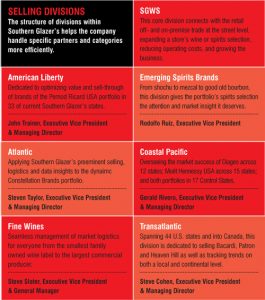 There was no overlap in Western Region President Patrick Daul’s territory. “Our region is home to some of Southern’s oldest markets like California, Arizona and Nevada,” he says. “Places that have tremendous resources and generate a lot of capital. Over the last decade we’ve applied best practices from these established markets to newer regions like Hawaii, New Mexico and the Pacific Northwest, and with the Glazer’s integration we’re sharing our expertise with markets outside our region as well.”
There was no overlap in Western Region President Patrick Daul’s territory. “Our region is home to some of Southern’s oldest markets like California, Arizona and Nevada,” he says. “Places that have tremendous resources and generate a lot of capital. Over the last decade we’ve applied best practices from these established markets to newer regions like Hawaii, New Mexico and the Pacific Northwest, and with the Glazer’s integration we’re sharing our expertise with markets outside our region as well.”
By contrast, the Central Region was trickier, with the highest level of assimilation required. “Indiana was the only state where we had to completely integrate two separate businesses,” says Mike McLaughlin, President Central Region. “Neither warehouse could accommodate us, so we had to outfit an entirely new facility in less than nine months. Our team was methodical and exceeded expectations; they did a fantastic job of not allowing disruptions to customers.”
While data integration has been the biggest challenge across all regions, according to Slater—“merging two different systems with different product codes takes time and dedication”—the transition has been easier than anyone thought. “People ask me how the merger is going,” says Slater. “I tell them we don’t even talk about the merger anymore; it’s already in the rearview mirror.”
Stronger Than the Sum of Their Parts
Leadership made a critical decision from the beginning—to adopt the best practice regardless of which organization it came from. Although Glazer’s was in 11 states, compared to Southern’s 35, the company operated with a regional structure, an approach that Southern decided to apply to all their markets.
“We had been a very flat organization,” says Vassar. “In spite of our growth, we didn’t have another layer of management; the general managers of each state were reporting to me. Adopting Glazer’s regional approach—breaking up the business into three geographic regions, plus Control States, with management making decisions closer to the field—was really significant. The most exciting part about this merger was creating something totally new, hand-picking the four people to run the regions and letting them hand-pick their teams.”
Employee engagement was another one of Glazer’s strength, believes Wittig, who has a unique perspective, having worked for both companies. “Glazer’s philosophy on internal communication was really impressive,” he shares. “They created the Glazer’s News Network [now Southern Glazer’s News Network – SGNN] to provide timely news, videos and information to all employees. We’ve replicated that and it’s been extremely helpful, particularly during the merger. It pops up as every employee’s home page and can be customized for local markets.”
From a tactical standpoint, Southern was a leader. “We’ve built proprietary data collection systems that are second to none, and the Glazer’s legacy markets are really benefitting from this,” shares Vassar. The company is also on the vanguard of measuring performance with their Execution Tracking Tool, a phone app currently used by almost 10,000 employees. Sales reps take photos of brand displays and wine-by-the-glass placements, which are geo-stamped by location; results are instantly updated, and scorecards are produced. “The more we check on things the better we become,” Vassar says. “The way we executed and measured activation leading up to Yellowtail’s Super Bowl advertising last year was a perfect case of how this technology drove a behavior that gave real results.”
A New Supplier World
Large and small suppliers are starting to realize that SGWS has indeed built a better mousetrap. “Because we have a consistent approach in every market, suppliers are hearing the same thing across the country,” says Wittig. “Suppliers prefer having fewer points of contact, and my peers and I have terrific chemistry—there are no egos or politics, which provides seamless execution of standard business practices across all our regions.”
“The reaction of the supplier community has proven we are doing what the market wants and needs,” argues McLaughlin. “Companies like Bacardi, Campari and Beam Suntory signing on with us nationally really validates our decision to merge.”
It isn’t simply having a bigger footprint that matters to suppliers, believes Vassar: “It’s about transparency, it’s about synergy, and it’s about maximizing opportunity. At the end of the day, they expect us to execute more effectively and efficiently.” Having access to a broader range of more accurate data has changed the wholesaler-supplier dialogue, says Slater: “When we are collaborating on an effort, we can show current sales data, active accounts, growth rates and make realistic goals and predictions.”
With unique supplier perspective, having spent ten years at Moët Hennessy building their Control State Division, Oppenheimer recalls the game-changing experience when Diageo and Moët Hennessy chose to align with Southern in all markets. “We went from dealing with six different brokers with different routes to market and technology capabilities, to being able to set up one call and speak to every Control State manager and run national programs. Today, SGWS is the only broker with a national footprint in all Control States. Our suppliers love that that they can receive the same report and monthly recap from 17 states.”
The Enhanced Customer Experience
The first customers to feel the difference were national accounts, says McLaughlin, whose Central Region is heavily chain-dominated. “Being a one-stop shop for some of these large restaurants and retailers, who see us execute at a high level, solve problems and provide the most accurate and complete data, makes us very valuable to them. Our new National Accounts Division, led by Shawn Thurman, can now approach national account buyers and tell them: ‘Over 95% of your stores or restaurants are in regions where we operate, we can track programs with real-time feedback’.”
Independent restaurants and retailers won’t see much change, assures Vassar. The only difference he hopes they will notice is a more highly-educated, knowledgeable sales representative. “You can never overinvest in training,” Vassar believes. “We’ve really raised the bar on what a fine wine sales representative should be [see next page].” With 15 Master Sommeliers and 17 Master Mixologists on staff leading classes, and online courses available through Southern Glazer’s University, the company has also implemented an intensive manager’s course, with 90 days of coaching and in-market training.
The Myth About Big
Still, being “too big” is something that Slater still hears a lot: “When someone refers to our size, I would ask instead that we be judged on our service, not our size. We are the best in logistics, have the best portfolio and the best-trained people on the street.”
Slater gives the example of the Fine Wine Summit, now in its seventh year. The three-day event, held in a different wine region every year, brings general managers of all fine wine divisions for immersive education. “Last year we went to Oregon’s Willamette Valley—and we heard a lot of references to our size,” he remembers. “When they saw that I brought the country’s most powerful fine wine divisions and 15 Master Sommeliers to learn about Oregon’s terroir and emerging AVAs, they were incredibly thankful. Only ‘big’ can do that.”
“What our size gives us—and what separates us from the competition—is the investment in our people and technology. It’s about having the resources and commitment to constantly improve,” says Daul. Just a few years ago, forecasting supply wasn’t Southern’s strength, but that has changed dramatically, which is a huge benefit to suppliers managing costs. A deeper understanding of finance and reporting metrics is another area where the company has improved leaps and bounds in recent years, he adds.
Finding Opportunity in Challenging Times
Having a competitive advantage is especially critical when the market softens—as it has over the last six months. “There has been a slow-down overall,” reports McLaughlin. “The wine business is no longer growing; on-premise is soft. With the exception of Deep Eddy and Tito’s, even vodka has become a tough category. We are looking at these challenges trying to get a better understanding of what’s causing it.”
All SGWS regions report the necessity of maximizing opportunities; tapping into the growth of ultra-premium tequila, American and Irish whiskey, Prosecco and red blends. Understanding what ignites a trend makes it possible to drive it, says Daul, such as the resurgence in gin led by the popularity of the Negroni. “Craft mixology in general can create trial in a category that consumers are less comfortable with, like gin.”
Fortunately, trade-up continues despite the dip in total volume. “We are fortunate in Control States and Canada that each market has a long history of volume and value growth,” notes Oppenheimer. “The liquor boards are focused on value growth and implementing new innovations to move consumers up the value chain.”
“I remain extremely bullish on the wine and spirits business—the demographics in America are in our favor for the foreseeable future; these products are part of our lifestyle,” Vassar states. But the need to evolve remains, he cautions: “Online purchasing, which has seriously impacted many other retail businesses, will be a reality for the wine and spirits industry, too. We are urging retailers to have some sort of web presence—whether doing it themselves, or having a rapid delivery service like Drizly do it for them. Independent retailers—and to me they remain the heart and soul of our business because they carry a broad range of SKUs—need to think about their businesses in new ways because the challenges aren’t going away.”
As for their own business, the merger is just one step further in adapting to the ever changing market: “We want to respect the past and path that people have walked, but to also embrace the future and where this company is going,” says Daul.
“The merger is only a year old, but we are in a much greater place than we thought we would be,” says Wittig. “But we must constantly improve and find new efficiencies. That is our business. Particularly as the largest wholesaler, we have more responsibility to enhance our abilities to serve our customers. And that work will never end.”
Raising the Fine Wine Bar
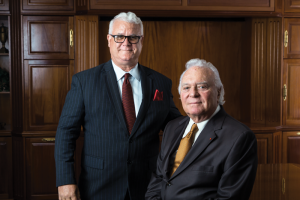
Steve Slater, Executive Vice President, General Manager, Wine and Mel Dick, Senior Vice President, President, Wine Division.
Prior to the merger with Glazer’s, Southern Wine & Spirits had long been recognized as an industry leader in wine and wine education: Today the company has 15 Master Sommeliers on staff. Glazer’s legacy markets are benefiting from this focus, and the entire company is doubling down on its commitment to fine wine. “Both companies share a commitment to growing wine,” says Mel Dick, Senior Vice President and President, Wine Division. “Glazer’s had a great wine business, but they want to make it bigger and we think we can help them do that.”
Few people in the industry have the perspective of Dick: “I joined Southern in March of 1969, a number of months after it was founded. That year we sold $890,000 of wine. This year we’ll do close to $6.6 billion. Wine represents 50% of our case volume.”
It didn’t happen overnight. “When Steve Slater joined Southern in 1989 in California, it was a much smaller wine company,” he recalls. “When Mel and the other leadership wanted to strengthen the wine business in the early 1990s, it was a turning point in California. Ownership and leadership had tremendous vision with what we could do in wine.”
The secret to their wine business success, Slater firmly believes, has been their unique, multi-pronged approach to the marketplace through the creation of fine wine companies or divisions to handle high-end, small producers. “In the early 1990s, Southern created American, a fine wine distributor in California,” he recalls. “And I watched their team build a portfolio of coveted boutique brands.” Vassar tapped Slater to head the division several years later. “Moving Schieffelin & Somerset’s business to American was really the beginning of what became a $300 million company,” Slater says.
SGWS has employed this model across the country, and when fine wine divisions become too large, smaller divisions are created underneath them.
In Seattle, Southern acquired Cavatappi, a small fine wine wholesaler and has launched a new fine wine division for the Pacific Northwest, called American Wine & Spirits. “We have learned a lot in new markets, and today we allow these small companies’ cultures to remain intact,” notes Slater. “We occasionally use separate delivery trucks; there has to be a different look and feel for a portfolio that reaches a different customer.”
Investment in People & Education
The merger has resulted in manpower ramp-ups across the country, Slater describes: “There were different needs in each market: Florida needed Italian wine and craft spirits specialists, California wanted more sales reps as well as a smaller fine wine division.” National Accounts teams were given portfolio managers to focus on chain opportunities for larger-scale brands; and on the fine wine side, there are three new directors of strategy, each looking after about 20 suppliers.
“Young consumers are so much more curious,” observes Dick. “The American consumer is probably the most knowledgeable wine consumer in the world today. And they are trading up: The $15 to $25 range, that’s where the action is.”
That sophistication—as well as the savvy of today’s beverage buyer—demands a different approach. “The buyer has changed; to speak with highly-educated sommeliers we need highly-polished sales representatives,” Slater says. SGWS has installed a rigorous education program, led by Eric Hemer, a dual Master of Wine and a Master Sommelier (one of four in the world), and today 3,800 of their sales reps have WSET Level 2 Certification, with the goal of reaching 10,000.

